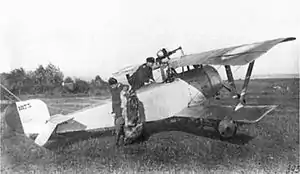Nieuport 21
The Nieuport 21 (or Nieuport XXI C.1 in contemporary sources) was a French single-seat, single-engine fighter aircraft used during World War I. The aircraft was used by the French, Russian, British and American air forces. After the war, the Nieuport 21 was a popular civil aircraft.
| Nieuport 21 | |
|---|---|
 | |
| Role | Fighter |
| Manufacturer | Nieuport |
| Introduction | 1916 |
| Retired | 1920s |
| Primary users | Aéronautique Militaire Imperial Russian Air Service US Army Air Service |
| Developed from | Nieuport 17 |
Design and development
The Nieuport 21 was designed by Gustave Delage and it made its maiden flight in 1916. While it had a similar airframe to the Nieuport 17, it was equipped with a less powerful Le Rhône 9C engine as it was originally intended as a long range escort fighter. As the engine was fitted with a horseshoe shaped cowling, the Nieuport 21 was often mistaken for the slightly smaller Nieuport 11, which used the same cowling.[1]
Operational history
.jpg.webp)
The Nieuport 21 served alongside the more powerful Nieuport 17, where its lower weight helped boost its already impressive climb rate. Although initially intended as a bomber escort, this role was abandoned when the bombers were withdrawn from daylight operations. Large numbers were also built for training duties. Nieuport 21s were sold to Russia, and to the United States for use as trainers. The Nieuport 21 was license manufactured in Russia by Dux Factory. Examples were also used in limited numbers by the Royal Naval Air Service. A small number were used by a number of air arms in the early post war period, including the Finnish Air Force (the Whites) which had captured a Russian aircraft in Tampere in 1918 and which was used until 1923. The French Navy used one example for carrier trials in 1919 and 1920. Due to its similarity to the Nieuport 11, many operated by air forces post-war have been misidentified in the past as Nieuport 11s, few of which survived that long.
Operators
- Estonian Air Force - Postwar
- Red Guards (ex-Russian examples)[2]
- Luchtvaartafdeling - operated 5 Nieuport 21s as 80 HP Nieuports.[3]
- Soviet Air Forces operated ex-Imperial Russian Air Service.
- Royal Naval Air Service
- Five aircraft only.
Specifications


Data from French Aircraft of the First World War[5] and Nieuport 1875-1911[6]
General characteristics
- Crew: 1
- Length: 5.80 m (19 ft 0 in)
- Upper wingspan: 8.16 m (26 ft 9 in)
- Upper Chord: 1.233 m (4 ft 0.5 in)
- Wing Sweep: 3° 20'
- Lower wingspan: 7.80 m (25 ft 7 in)
- Lower Chord: 720 m (2,360 ft)
- Height: 2.40 m (7 ft 10 in)
- Wing area: 14.75 m2 (158.8 sq ft)
- Airfoil: N[6]
- Empty weight: 350 kg (772 lb)
- Gross weight: 530 kg (1,168 lb)
- Undercarriage track: 1.60 m (5 ft 3 in)[6]
- Powerplant: 1 × Le Rhône 9C air-cooled rotary engine, 60 kW (80 hp)
- Propellers: 2-bladed Levasseur 450[6] or Régy 310[7] fixed pitch wooden propeller, 2.50 m (8 ft 2 in) diameter [7]
Performance
- Maximum speed: 150 km/h (93 mph, 81 kn)
- Range: 250 km (160 mi, 130 nmi)
- Endurance: 2 hours
- Service ceiling: 5,200 m (17,100 ft)
- Time to altitude:
- 8.45 minutes 2,000 m (6,600 ft)
- 15.7 minutes 3,000 m (9,800 ft)
Armament
- Guns: 1 x .303 in (7.7 mm) Vickers machine gun
See also
Related development
Aircraft of comparable role, configuration, and era
Related lists
References
Notes
- Taylor and Alexander 1969, pp. 114–115.
- Berner, Aarne (1934). "Air Force Participation in Finnish War of Independence in Year 1918. Chapter III. Red Air Activity in Finland y. 1918" (PDF). Retrieved 4 November 2017.
- url=https://kw.jonkerweb.net/index.php?option=com_content&view=article&id=592:nieuport-21-and-23-uk&catid=93&lang=en&Itemid=555&showall=1&limitstart=
- Dan Antoniu (2014). Illustrated History of Romanian Aeronautcs 1909-1948.
- Davilla, 1997, p.389
- Pommier, 2002, p.178
- Hartmann, 2015, p.20
Bibliography
- Cejka, Zdenek (January 2001). "Les Nieuport Techécoslovaques" [The Czech Nieuports]. Avions: Toute l'Aéronautique et son histoire (in French). No. 94. pp. 38–47. ISSN 1243-8650.
- Davilla, Dr. James J.; Soltan, Arthur (1997). French Aircraft of the First World War. Mountain View, CA: Flying Machines Press. pp. 388–389. ISBN 978-1891268090.
- Gerdessen, F (July–August 1999). "Round-Out: More Windfalls". Air Enthusiast. No. 82. pp. 79–80. ISSN 0143-5450.
- Hartmann, Gérard (6 January 2015). "Les héliciers français" (PDF) (in French). Retrieved 5 August 2019.
- Keskinen, Kalevi; Partonen, Kyösti; Stenman, Kari (2005). Suomen Ilmavoimat I 1918–27. Espoo, Finland: Kari Stenman. ISBN 9529943229.
- Pommier, Gerard (2002). Nieuport 1875-1911 — A biography of Edouard Nieuport. Atglen, PA: Schiffer Publishing. p. 178. ISBN 978-0764316241.
- Taylor, John W. R.; Alexander, Jean (1969). Combat Aircraft of the World. New York: G.P. Putnam's Sons. ISBN 0718105648.